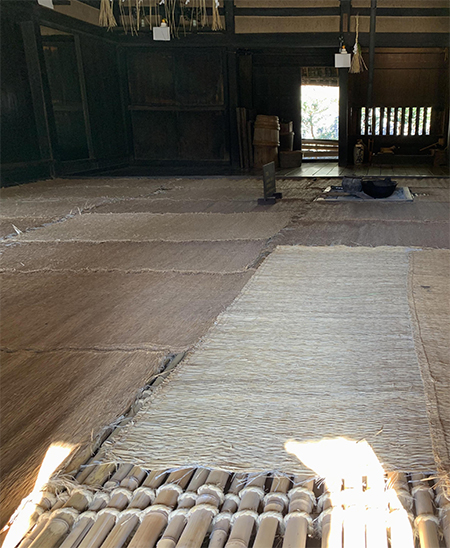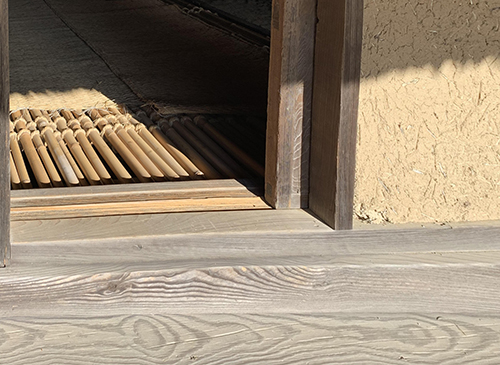


さて現神奈川県秦野に334年前からあった古民家最終回。
日本の古民家探訪というのは、古層の民俗を掘り起こす感覚にいちばん近い。
現代を我々は生きているけれど、そのわたしたちの生き方の基盤は
こういった古民家の民俗性に根源があるのだと思わされる。
そう考えてくると、やはり「ハレ」の空間には「大事にしてきたこと」が
鮮明にピンナップされているものなのでしょう。
祖先への帰依を強く感じさせられる仏壇や精神性を伝える床の間。
やはりこの列島社会では、こうした価値感でわれわれは生き延びてきた。
そういうなかでもやはり「畳の間」という文化は格別。
江戸時代中期、まさにこの家の建てられた頃くらいまで
一般庶民は「畳の間」が普及していなかったとされています。
全国畳産業振興会HPをみると、
「中国伝来のものが多いなかで、畳は日本固有の敷物。その歴史は
「菅畳八重」「皮畳八重」などの記述がある古事記にまでさかのぼります。
まだ畳床などはなく、コモなどの敷物を重ねたものと推測されます。
現在の畳に似た構造になったのは平安時代。板敷に座具や寝具として
置くという使い方で、使う人の身分によって畳の厚さやへりの柄・色が異なりました。
鎌倉時代から室町時代にかけ、書院造が生まれて、部屋全体に
畳を敷きつめる使い方に発展しました。それまでは高貴な人や客人の
もてなしのためのものでしたが、建物の床材として利用されるようになったのです。
しかしそうした使い方も貴族や武士の富の象徴。
桃山時代さらに江戸時代に至るなかで、数奇屋造や茶道が発展して普及し、
徐々に町人の家にも畳が敷かれるようになりました。
それでも身分による畳の制限の風習は残り、庶民が使用できるようになったのは
江戸時代中期以降。畳師・畳屋と呼ばれる人々が活躍し、
畳干しする家々の光景があちこちで見られるようにいなりました」
と記述されています。
なぜ日本独自で畳という進化した床素材があるのか、
本当にオモシロい民俗だと思われてならない。
畳の間で仏壇・床の間が装置されるという、ジャパンオリジナル空間。
これは誰が作ったという文化ではなく、日本という社会が作ってきた規範。
座るということに深くこだわった結果がこの畳文化なのか、
いやそうではなく、畳とは最上級の「寝室床」ということで
言ってみればベッドとカーペットの中間的存在で日本独自に発展したものか。
体感的に言えば畳の間では、つい寝そべりたくなって「大の字」になる。
板敷きの床ではあんまりそんな衝動には駆られないけれど、
畳の間ではついそうしたくなるのにはきっと理由があるのでしょう。
そういう空間に先祖が祀られているのには、日本人的感受性が表現されている。


一方で、この家の竹簀の子敷き+ムシロカーペットという構成も
いかにも地域の気候風土に柔軟に対応しようとする民俗が感じられる。
第一、床が竹だと毎日が「竹踏み健康法」になるではないか(笑)。
ツボが刺激されていいとされている。
身分制での規制があったことで逆に庶民はどんどん健康になった?
前向きに考えるという意味では、有効な社会環境だったとも思える。
現代住宅では自由に素材選択可能であるけれど、
こういった民族体験はかならず投影されていくものでしょうね。
English version⬇
[Floor material for old folk houses "Hare and Ke" / Good Japanese house ㉒-4]
By the way, the last inning of an old folk house that has existed in Hadano, Kanagawa Prefecture for 334 years.
Exploring old Japanese houses is the closest to digging up old folk.
We live in the present age, but the foundation of our way of life is
It seems that the folk nature of these old folk houses has their roots.
When I think about it, there is something that I have cherished in the space of "Hare".
It must be clearly pinned up.
A Buddhist altar that makes you feel strongly devoted to your ancestors and an alcove that conveys spirituality.
After all, in this archipelago society, we have survived with such a sense of value.
Even so, the culture of "tatami mats" is exceptional.
Until the middle of the Edo period, when this house was built
It is said that the "tatami room" was not popular among the general public.
Looking at the National Tatami Industry Promotion Association HP ,
"Among many of them from China, tatami is a rug unique to Japan. Its history is
It goes back to the Kojiki with descriptions such as "Suga tatami mat Yae" and "Skin tatami mat Yae".
There are no tatami floors yet, and it is presumed that rugs such as como are piled up.
It was during the Heian period that the structure resembled the current tatami mats. As a seat or bedding on a board
The thickness of the tatami mat and the pattern and color of the edge differed depending on the status of the user.
From the Kamakura period to the Muromachi period, Shoin-zukuri was born, and the entire room
It has evolved into a way of using tatami mats. Until then, of noble people and guests
It was for hospitality, but it has come to be used as a flooring material for buildings.
However, such usage is also a symbol of the wealth of aristocrats and samurai.
During the Momoyama period and the Edo period, Sukiya-zukuri and tea ceremony developed and became widespread.
Gradually, tatami mats were laid in the houses of the townspeople.
Even so, the custom of restricting tatami mats by status remained, and it was only possible for ordinary people to use it.
Since the middle of the Edo period. People called tatami mat masters and tatami mats are active,
You can now see the sights of tatami-dried houses here and there. "
It is described as.
Why is there an evolved floor material called tatami that is unique to Japan?
Don't think it's a really funny folklore.
A Japan-original space where the altar and alcove are installed between tatami mats.
This is not a culture of who created it, but a norm created by the Japanese society.
Is this tatami culture the result of a deep commitment to sitting?
No, not so, tatami is the highest grade "bedroom floor"
So to speak, it is an intermediate between the bed and the carpet, and it was developed uniquely in Japan.
Speaking sensibly, between tatami mats, you just want to lie down and become a "large letter".
I can't really drive such an urge on a wooden floor,
There must be a reason why you want to do that between tatami mats.
The fact that ancestors are enshrined in such a space expresses Japanese sensitivity.
On the other hand, the composition of this house's bamboo duckboard + Mushiro carpet is also available.
You can feel the folklore trying to flexibly respond to the local climate.
First, if the floor is made of bamboo, every day will become a "bamboo stepping health method" (laughs).
It is said that the acupoints are stimulated.
Did the common people get healthier and healthier because of the restrictions on social division?
In terms of thinking positively, it seems that it was an effective social environment.
In modern houses, you can freely select the material,
This kind of ethnic experience will always be projected.



















